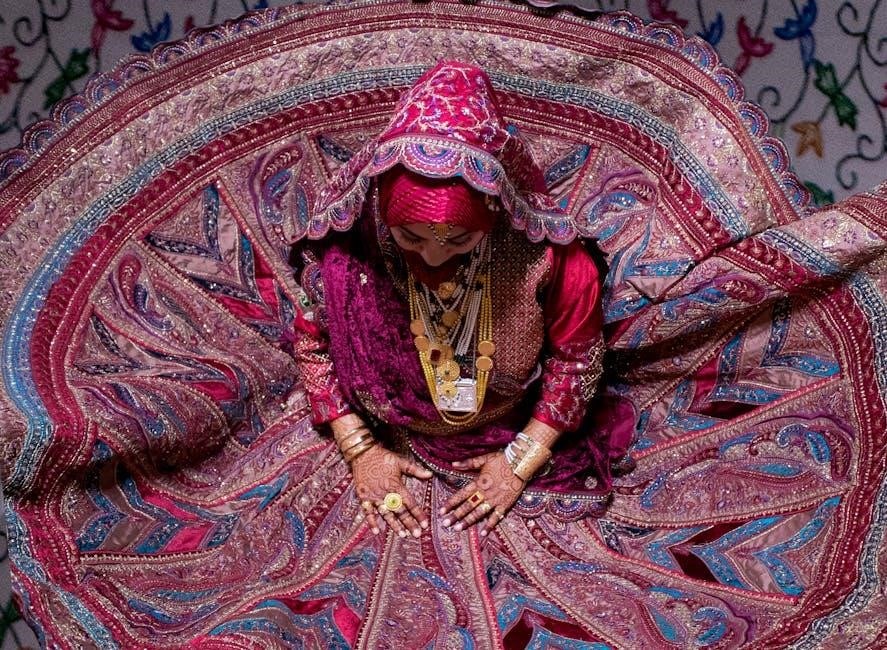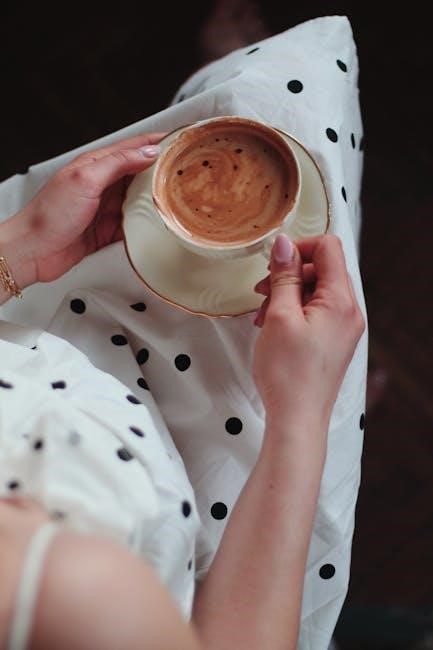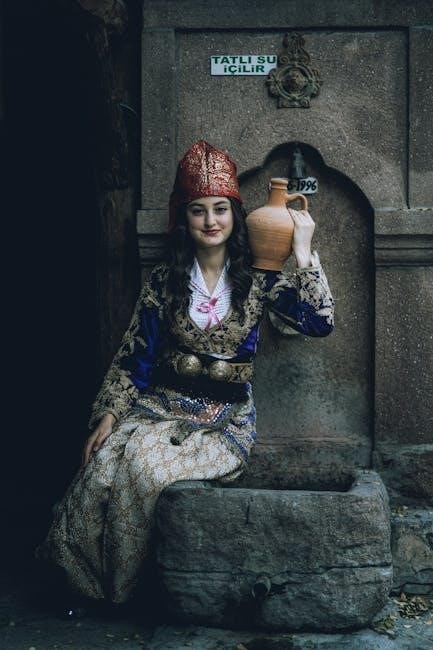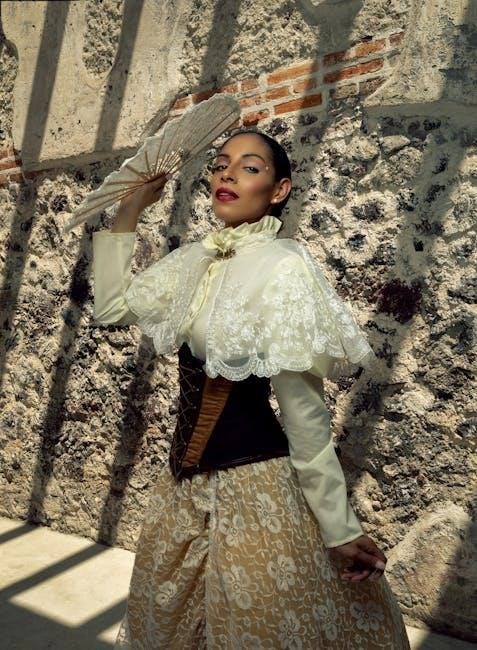Discover the charm of free vintage dress patterns‚ offering a timeless aesthetic and creative freedom. Perfect for crafting unique‚ authentic garments with a nostalgic flair‚ these patterns are easily accessible in PDF format‚ making them ideal for both experienced sewists and newcomers alike.
What Are Vintage Dress Patterns?
Vintage dress patterns are reproductions or original designs from past decades‚ often reflecting the fashion of the 1920s to the 1970s. These patterns capture the essence of bygone eras‚ featuring iconic silhouettes‚ intricate details‚ and classic sewing techniques. They are typically available as PDF downloads‚ making them accessible for modern sewists. Vintage patterns often include unique elements like flared skirts‚ fitted bodices‚ or retro accessories‚ allowing creators to craft authentic‚ timeless garments. Many are free‚ offering a budget-friendly way to explore historical fashion. Whether for nostalgic appeal or a personalized wardrobe‚ vintage dress patterns provide a creative gateway to sewing authentic‚ stylish dresses with a touch of the past.
Why Choose Free Vintage Patterns?
Choosing free vintage patterns offers a cost-effective way to explore historical fashion while enhancing your sewing skills. These patterns provide access to timeless designs‚ allowing you to create unique‚ authentic garments without the expense. They are ideal for those interested in sustainable fashion‚ as they encourage upcycling and repurposing of fabrics. Free vintage patterns also cater to various skill levels‚ from beginners to experienced sewists‚ making them a versatile choice. Additionally‚ they offer a creative outlet to experiment with different eras and styles‚ helping you craft a wardrobe that stands out with a nostalgic charm. Embracing free vintage patterns is a practical and inspiring way to connect with the past while contributing to a sustainable sewing practice.
Benefits of Using PDF Patterns
PDF patterns offer unparalleled convenience and flexibility for modern sewists. They provide instant access to designs‚ eliminating the need for physical storage and allowing easy organization on digital devices. PDFs are scalable‚ enabling users to print only the sizes they need‚ which reduces waste. Additionally‚ they often include layered printing options‚ making it easier to customize patterns to your preferences. The digital format also allows for seamless updates and corrections‚ ensuring you always have the most accurate version. PDF patterns are environmentally friendly‚ as they eliminate the need for shipping and physical materials. Their versatility and accessibility make them a popular choice for sewists of all skill levels‚ empowering creators to bring their visions to life with ease and efficiency.

Where to Find Free Vintage Dress Patterns
Explore reputable websites like Mood Fabrics and Etsy‚ or platforms like Seamwork‚ offering free vintage dress patterns in PDF format for instant download and creative sewing projects.
Reputable Websites for Download
Several trusted websites offer free vintage dress patterns in PDF format. Mood Fabrics provides a vast collection‚ while Etsy features unique‚ curated selections from independent sellers. Seamwork and similar platforms also offer high-quality patterns with clear instructions‚ perfect for both beginners and experienced sewists. These sites ensure authenticity and ease of use‚ allowing you to download and start your project immediately. Additionally‚ some platforms like Sew Over It and Tilly and the Buttons offer vintage-inspired patterns with modern twists‚ catering to diverse sewing preferences. Always verify the source and reviews to ensure you’re downloading from reliable providers.
Etsy and Other Marketplaces
Etsy is a top destination for free vintage dress patterns in PDF format‚ offering a wide variety of unique and authentic designs from independent sellers. Many Etsy shops specialize in vintage sewing patterns‚ providing high-quality digital downloads that are easy to access and print. While some patterns may require purchase‚ others are available for free‚ making it a great resource for budget-conscious crafters. Additionally‚ other marketplaces like eBay and specialized sewing platforms often feature vintage patterns‚ including rare and hard-to-find designs. When using these platforms‚ be sure to check seller reviews and ratings to ensure a smooth and reliable downloading experience. This makes Etsy and similar sites invaluable for sewing enthusiasts seeking timeless styles.

Seamwork and Similar Platforms
Seamwork stands out as a premier platform offering free vintage dress patterns in PDF format‚ catering to both beginners and experienced sewists. By subscribing to their magazine‚ users gain access to a curated selection of patterns‚ including vintage-inspired designs. These patterns are instantly downloadable‚ ensuring a seamless sewing experience. Seamwork’s platform is user-friendly‚ allowing crafters to explore and download patterns effortlessly. The variety of styles and eras available makes it a go-to resource for those seeking authentic vintage aesthetics. This approach not only preserves traditional sewing techniques but also encourages creativity and innovation in modern garment-making.
Other Online Resources
Beyond dedicated platforms‚ numerous online resources offer free vintage dress patterns in PDF format. Websites like Mood Fabrics provide an impressive array of downloadable patterns‚ while YouTube channels and sewing blogs share tutorials and insights for working with vintage designs. Additionally‚ many independent creators and historical archives offer free patterns‚ preserving traditional sewing techniques. These resources often include guides on fabric selection‚ sizing adjustments‚ and authentic stitching methods. For enthusiasts‚ online forums and communities further enhance the sewing experience by sharing tips and showcasing finished projects. These diverse resources collectively cater to sewists of all skill levels‚ fostering creativity and a connection to sewing’s rich heritage.

How to Download and Use Free Vintage Dress Patterns
Accessing free vintage dress patterns in PDF format is simple. Download instantly‚ print‚ and adjust for a modern fit. Perfect for all skill levels.
Step-by-Step Download Guide
- Visit a reputable website offering free vintage dress patterns in PDF format.
- Browse the collection by era‚ style‚ or size to find your desired pattern.
- Click on the pattern to view details‚ including size options and fabric requirements.
- Review and agree to any terms of use or copyright restrictions.
- Download the PDF directly to your device‚ ensuring a stable internet connection.
- Open the PDF using a compatible viewer and print the pattern pieces on standard paper.
- Assemble the pattern by matching the provided markers or labels.
- Use the printed pattern to cut fabric and sew your vintage-inspired dress.
This process ensures a seamless experience for sewists of all skill levels.
Printing and Assembling Patterns
Printing and assembling free vintage dress patterns requires attention to detail for accuracy. Ensure your printer is set to “Actual Size” or “100%” scale to maintain correct measurements. Print the pattern on standard paper‚ as most PDFs are designed for 8.5×11-inch sheets. Use scissors or a craft knife to carefully cut out each pattern piece along the lines. Match the markers and labels on adjacent pages to align the edges properly. Tape the pieces together to form the complete pattern. Some patterns may include a test square to verify print accuracy. Once assembled‚ your pattern is ready to use for cutting fabric. Always refer to the included instructions for any specific assembly tips or adjustments needed for your project.

Adjusting Sizes for Modern Fit
Adjusting free vintage dress patterns for a modern fit is essential for achieving comfort and a flattering silhouette. Vintage patterns often have different ease allowances compared to modern designs‚ so it’s crucial to understand the intended ease in the original pattern. Start by taking your body measurements and comparing them to the pattern’s size chart. If needed‚ grade the pattern up or down to match your measurements. Consider lengthening or shortening hemlines and sleeves to suit contemporary styles. Additionally‚ pay attention to fit adjustments like darts‚ waistlines‚ and bust lines‚ which may need modification for a modern aesthetic. Small alterations can make a vintage pattern work beautifully for today’s body types and fashion preferences.
Tips for Working with Vintage Patterns
Understand pattern ease‚ choose fabrics suited to the era’s style‚ and make necessary fit adjustments. Study original instructions and don’t hesitate to add modern tweaks for comfort.

Understanding Ease in Patterns
Understanding ease is crucial when working with vintage patterns. Ease refers to the extra space built into a pattern for comfort and movement. Vintage patterns often have minimal ease compared to modern designs‚ which can feel restrictive to contemporary sewists. To achieve the desired fit‚ measure carefully and compare your body measurements to the pattern’s specifications. Adding or subtracting ease can significantly impact the garment’s look and comfort. Study the pattern’s instructions and consider resources like Sewcabulary‚ which explains ease in detail. Adjusting ease ensures a flattering‚ functional fit while maintaining the pattern’s vintage charm. Proper ease management is key to successful vintage sewing projects.
Common Mistakes to Avoid
When working with free vintage dress patterns‚ several common mistakes can hinder success. One major error is ignoring size conversions‚ as vintage sizing differs significantly from modern standards. Failing to account for ease can result in garments that are too tight or restrictive. Another mistake is not pre-washing fabric‚ which can cause shrinkage after sewing. Neglecting to read pattern instructions thoroughly often leads to construction errors. Additionally‚ using inappropriate fabrics for the pattern can affect the final result. To avoid these pitfalls‚ take the time to understand the pattern’s requirements‚ make necessary adjustments‚ and choose fabrics wisely. Proper preparation ensures a smoother sewing process and a more professional finish.
Fitting and Alterations
Fitting and alterations are crucial when working with free vintage dress patterns to ensure a flattering‚ modern silhouette. Understanding ease—extra fabric built into patterns for comfort—is key‚ as vintage patterns often have less ease than contemporary designs. Start by making a muslin or test garment to assess fit. Pay attention to areas like sleeve length‚ bodice darts‚ and waist placement‚ which may need adjustment for a modern figure. Common alterations include narrowing or widening seams‚ adjusting hemlines‚ or adding darts for a better fit. Don’t hesitate to tweak patterns to accommodate personal style or body type. With careful fitting‚ vintage patterns can be transformed into garments that blend timeless charm with a tailored‚ contemporary look.

Fabric Selection for Vintage Dresses
Choose fabrics like cotton‚ rayon‚ or silk for authenticity. Light to medium-weight fabrics with a soft drape are ideal for vintage dresses‚ ensuring a flowing‚ elegant appearance.
Choosing the Right Fabric
Selecting the right fabric is crucial for achieving the desired vintage look and feel. Opt for materials like cotton‚ rayon‚ or silk‚ which were commonly used in past decades. Light to medium-weight fabrics with a soft drape‚ such as voile or lawn‚ are ideal for flowing vintage dresses. Avoid heavy or stiff fabrics that may distort the pattern’s intended silhouette. Consider the season and occasion when choosing fabric—lighter fabrics for summer dresses and heavier ones for winter. Always prewash your fabric to ensure proper fit and avoid shrinkage after sewing. Matching the fabric weight and drape to the pattern’s recommendations will help create a authentic and professional finish.
Working with Vintage Fabrics
Vintage fabrics offer a unique charm‚ but they often require special care. Before cutting‚ inspect the fabric for any signs of damage or wear‚ such as frays or discoloration. Pre-treat delicate or antique fabrics by gently hand-washing and air-drying to prevent shrinkage. When sewing‚ use sharp needles and minimal pins to avoid further damage. Consider lining or interlining vintage fabrics to add stability and longevity. For patterns with intricate details‚ use a walking foot or Teflon foot to handle slippery or thin fabrics smoothly. Embrace any imperfections as part of the fabric’s history‚ enhancing the character of your final garment. Handling vintage fabrics with care ensures your project remains both beautiful and durable.
Sewing Tips for Vintage-Style Dresses
Mastering vintage-style dresses requires attention to detail and traditional techniques; Use period-appropriate fabrics‚ embrace hand-finishing‚ and focus on precise seamwork to achieve an authentic‚ timeless look. Incorporate vintage sewing tools and methods to enhance the nostalgic appeal of your garments‚ ensuring each stitch tells a story of craftsmanship and elegance. By blending modern convenience with classic practices‚ you can create beautiful‚ high-quality dresses that evoke the charm of bygone eras while maintaining a contemporary fit and feel. This approach not only honors the art of vintage sewing but also allows for personal expression and creativity in every project.
Techniques for Authentic Looks
Achieving an authentic vintage look involves mastering period-specific techniques. Start by understanding ease in patterns‚ ensuring a proper fit without modern stretch allowances. Use traditional sewing methods like hand-finishing seams and applying interfacing subtly. Incorporate details such as bound buttonholes‚ vintage-style darts‚ and gathers for a nostalgic feel. Choose fabrics reminiscent of past eras‚ such as cotton lawn or rayon‚ and opt for prints popular during the 1940s-60s. Pay attention to neckline shapes‚ sleeve styles‚ and hem lengths typical of the era. Embrace vintage tailoring techniques‚ like underlining and staystitching‚ to maintain structure. Finally‚ add embellishments like vintage buttons or embroidery to complete the look. These methods ensure your dress captures the essence of its inspiration‚ blending historical craftsmanship with modern sewing practices for a truly authentic appearance.
Using Vintage Sewing Tools
Using vintage sewing tools can elevate your sewing experience and add authenticity to your projects. Consider incorporating classic tools like vintage sewing machines‚ manual buttonhole scissors‚ or original notions from past decades. These tools often provide a tactile connection to historical sewing practices. For example‚ using a 1950s-era sewing machine can mimic the stitching style of the time. Additionally‚ vintage rotary cutters or dressmaker shears can enhance precision and nostalgic charm. Many of these tools are still functional and can be sourced from antique shops‚ estate sales‚ or online marketplaces. Embrace the unique character of these tools to create a sewing experience that aligns with the era of your pattern‚ adding a touch of heritage to your craft.

Alterations and Modifications
Vintage patterns often require adjustments for modern fits and preferences. Tailor designs by resizing‚ adding pockets‚ or updating necklines to suit contemporary tastes while preserving their charm.
Customizing Your Pattern
Customizing free vintage dress patterns allows you to tailor designs to your preferences. Resize patterns to fit modern measurements‚ add pockets‚ or adjust sleeve lengths for functionality. Combine elements from different eras to create unique looks. For instance‚ blend 1920s drop-waist simplicity with 1950s full skirts. Adjust necklines to suit modesty or style‚ and incorporate modern details like zippers or elastic. Use tutorials and guides to alter measurements without losing the pattern’s authenticity. Experiment with fabric choices to update the look while maintaining vintage charm. These modifications ensure your dress reflects personal style while honoring its historic inspiration. Clear instructions and step-by-step guides make customization accessible for all skill levels‚ ensuring a perfect fit and modern appeal.
Adding Modern Details
Add modern touches to your vintage dress patterns for a contemporary twist. Incorporate features like pockets‚ invisible zippers‚ or elastic waistbands for comfort and functionality. Update the neckline or sleeve length to suit current trends while maintaining the vintage charm. Use breathable fabrics or lightweight materials for a fresh feel. Embellish with modern trims‚ appliques‚ or embroidery to give the dress a unique flair. Experiment with color-blocking or contrasting linings for a subtle yet stylish update. These modern details enhance the design without losing the timeless appeal of the original pattern.
Resources for Vintage Sewing
Explore blogs‚ YouTube channels‚ and online communities dedicated to vintage sewing. These resources offer tutorials‚ tips‚ and inspiration for working with free vintage dress patterns‚ ensuring authenticity and creativity in your projects.
Recommended Blogs and Websites
Discover exceptional resources for vintage sewing with blogs like Mood Fabrics‚ offering a wide array of free patterns‚ and Seamwork‚ which provides curated PDF patterns. Websites such as The Spruce Crafts and Sew Over It are treasure troves for tutorials‚ tips‚ and inspiration. These platforms cater to both beginners and experienced sewists‚ ensuring a smooth journey through the world of vintage sewing. Explore these resources to find the perfect patterns‚ learn techniques‚ and stay updated on the latest trends in vintage fashion. They offer a wealth of knowledge and tools to enhance your sewing projects‚ making them indispensable for anyone passionate about creating authentic‚ timeless garments.
YouTube Channels for Tutorials
YouTube offers a wealth of tutorials dedicated to vintage sewing‚ providing step-by-step guidance for working with free vintage dress patterns. Channels like Sew Over It and With Wendy share detailed videos on pattern adjustments‚ fabric selection‚ and authentic stitching techniques. Lisa Comfort’s channel is another excellent resource‚ focusing on vintage-inspired garments and modern sewing methods. These channels not only help you master the basics but also inspire creativity by showcasing how to adapt vintage patterns to contemporary styles. Whether you’re a beginner or an experienced sewist‚ these tutorials offer invaluable insights and practical advice to bring your vintage projects to life with precision and flair.
Online Communities and Forums
Online communities and forums are invaluable resources for sewists working with free vintage dress patterns. Platforms like Reddit’s r/Sewing and specialized sewing forums offer a wealth of knowledge‚ tips‚ and support. These spaces allow users to share experiences‚ troubleshoot challenges‚ and showcase their creations. Many communities feature threads dedicated to vintage patterns‚ where members discuss fitting‚ fabric choices‚ and historical accuracy. Websites like Sewing Parts Online and PatternReview.com also host forums where sewists can exchange advice and learn from experts. These interactive spaces foster creativity and problem-solving‚ making them essential for anyone looking to refine their skills and successfully work with free vintage dress patterns.

Legal and Copyright Considerations
Respect copyrights when using free vintage dress patterns. Ensure patterns are in the public domain or properly licensed. Infringement can lead to legal consequences. Always verify ownership and seek permission when necessary.
Understanding Copyright Laws
Copyright laws protect original works‚ including vintage dress patterns. Patterns published before 1927 are generally in the public domain‚ meaning they can be freely used. However‚ reproductions or digitized versions of vintage patterns may still be copyrighted if they involve significant creative changes. Always verify the copyright status of a pattern before using or sharing it. Using copyrighted material without permission can lead to legal consequences. Public domain patterns are a safe choice for sewing projects‚ ensuring you avoid infringement. Respect intellectual property rights by seeking permission when the copyright owner is identifiable or when in doubt.
Seeking Permission to Use Patterns
When using vintage dress patterns‚ it’s essential to seek permission if the design is still under copyright. Start by identifying the copyright owner‚ often listed on the pattern or its packaging. If the owner is unknown or untraceable‚ consider the pattern public domain. For digital versions‚ contact the website or seller directly through their provided contact methods. Clearly state your intent to use the pattern and await a response. Permission ensures legal compliance and respects the creator’s rights. Always document any granted permissions for future reference. If unsure‚ err on the side of caution to avoid potential legal issues. Respect intellectual property to maintain ethical sewing practices.
Free vintage dress patterns offer a charming way to create unique‚ timeless garments. With easy access in PDF format‚ they inspire creativity for sewists of all skill levels.
Final Thoughts on Vintage Patterns
Vintage dress patterns offer a timeless charm‚ allowing sewists to create garments with a historical touch. They provide a unique opportunity to connect with the past while expressing modern style. The satisfaction of crafting a dress from a bygone era is unmatched‚ as it combines nostalgia with personal creativity. Exploring different decades and designs can inspire endless possibilities‚ catering to various tastes and preferences. With accessible resources and online communities‚ sewists can find support and inspiration to bring these patterns to life. Embrace the journey of working with vintage patterns and enjoy the joy of creating something truly special and meaningful.

Encouragement to Start Sewing
Embarking on a sewing journey with free vintage dress patterns is a rewarding adventure. These patterns offer a gateway to creativity‚ allowing you to craft unique‚ timeless garments. Whether you’re a beginner or an experienced sewist‚ vintage patterns provide a fun and inspiring challenge. The sense of accomplishment from bringing a historical design to life is incredibly fulfilling. Don’t hesitate to explore the world of vintage sewing—start with a simple pattern‚ experiment with fabrics‚ and enjoy the process of learning and growing. The sewing community is vast and supportive‚ offering countless resources and encouragement. Dive in and discover the joy of creating something truly special with your own hands.
